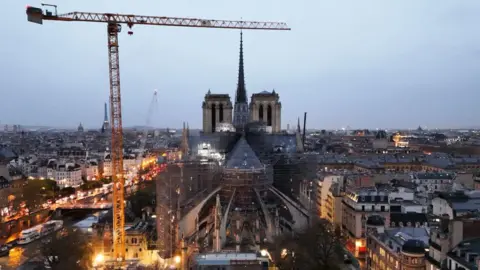The world gets a first look inside a resplendent new Notre-Dame on Friday, as France’s President Emmanuel Macron conducts a televised tour to mark the cathedral’s imminent re-opening.
Five-and-a-half years after the devastating fire of 2019, Paris’s Gothic jewel has been rescued, renovated and refurbished – offering visitors what promises to be a breathtaking visual treat.
The president – accompanied by his wife Brigitte and Archbishop of Paris Laurent Ulrich – are kicking off a programme of ceremonies that culminates with an official “entry” into the cathedral on 7 December and the first Catholic Mass the next day.
After being shown highlights of the building’s €700m (£582m) renovation – including the massive roof timbers that replace the medieval frame consumed in the fire – he will give a speech of thanks to around 1,300 craftsmen and women gathered in the nave.
Notre-Dame’s re-vamped interior has been kept a closely-guarded secret – with only a few images released over the years marking the progress of the renovation work.
But people who have been inside recently say the experience is awe-inspiring, the cathedral lifted by a new clarity and brightness that mark a sharp contrast with the pervading gloom of before.

“The word that will best capture the day is ‘splendour’,” said an insider of the Elysée closely involved with the restoration.
“People will discover the splendour of the cut stone, [which is] of an immaculate whiteness such as has not been seen in the cathedral maybe for centuries.”
On the evening of 15 April 2019, viewers around the world watched aghast as live pictures were broadcast of orange flames spreading along the roof of the cathedral, and then – at the peak of the conflagration – of the 19th Century spire crashing to the ground.
The cathedral – whose structure was already a cause for concern before the inferno – was undergoing external renovation at the time. Among the theories for the cause of the fire are a cigarette left by a workman, or an electrical fault.
Some 600 firefighters battled the flames for 15 hours.
At one point, it was feared that the eight bells in the north tower were at risk of falling, which would have brought the tower itself down, and possibly much of the cathedral walls.
In the end the structure was saved.
What was destroyed were the spire, the wooden roof beams (known as the “forest”), and the stone vaulting over the centre of the transept and part of the nave.
There was also much damage from falling wood and masonry, and from water from firehoses.
Thankfully what was saved made a much longer list – including all the stained-glass windows, most of the statuary and artwork, and the holy relic known as the Crown of Thorns. The organ – the second biggest in France – was badly affected by dust and smoke, but repairable.
Cathedral clergy also celebrated certain “miraculés” – miraculous survivors.
These include the 14th Century statue in the choir known as the Virgin of the Pillar, which narrowly avoided being crushed by falling masonry.
Sixteen massive copper statues of the Apostles and Evangelists, which surrounded the spire, were brought down for renovation just four days before the fire.
After inspecting the devastation the next day, Macron made what to many at the time seemed a rash promise: to have Notre-Dame re-opened for visitors within five years.
A public body to manage the work was created by law, and an appeal for funds brought an immediate response. In all €846m were raised, much from big sponsors but also from hundreds of thousands of small donors.
Responsibility for the task was given to Jean-Louis Georgelin, a no-nonsense army general who shared Macron’s impatience with committees and the “heritage” establishment.
“They’re used to dealing with frigates. This is an aircraft-carrier,” he said.
Georgelin is given universal credit for the project’s undoubted success, but he died in an accident in the Pyrenees in August 2023 and was replaced by Philippe Jost.
An estimated 2,000 masons, carpenters, restorers, roofers, foundry-workers, art experts, sculptors and engineers worked on the project – providing a huge boost for French arts and crafts.
Many trades – such as stone-carving – have seen a big increase in apprenticeships as a result of the publicity.
“[The Notre Dame project] has been the equivalent of a World Fair, in the way it has been a showcase for our craftsmanship. It is a superb shop-window internationally,” said Pascal Payen-Appenzeller, whose association promotes traditional building skills.
The first task of the project was to make the site safe, and then to dismantle the massive tangle of metal scaffolding that had previously surrounded the spire but melted in the fire and fused with the stonework.

Early on a decision had to be made about the nature of renovation: whether to faithfully recreate the medieval building and the 19th Century neo-Gothic changes wrought by architect Eugène Viollet-le-Duc, or to use the opportunity to mark the building with a modern imprint.
An appeal for new designs produced unusual ideas, including a glass roof, a green “eco-roof”, a massive flame instead of a spire, and a spire topped by a vertical laser shooting into the firmament.
In the face of opposition from experts and the public, all were abandoned and the reconstruction is essentially true to the original – though with some concessions to modern materials and safety requirements. The roof timbers, for example, are now protected with sprinklers and partitioning.
The only remaining point of contention is over Macron’s desire for a modern design for stained-glass windows in six side-chapels. Artists have submitted entries for a competition, but there is stiff opposition from many in the French arts world.
Macron has tried to make the renovation of Notre-Dame a theme and a symbol.
He has closely involved himself with the project, and visited the cathedral several times.
At a moment when his political fortunes are at an all-time low – following bruising parliamentary elections in July – the re-opening is a much-needed boost for morale.
Some said he was stealing the limelight by organising Friday’s ceremony – officially to mark the end of the project – a week ahead of the formal re-opening. It means that the first, long-awaited images of the interior will also inevitably focus on him.
In answer Elysée officials point out that the cathedral – like all French religious buildings under a law of 1905 – belongs to the state, with the Catholic Church its “assigned user”; and that without Macron’s rapid mobilisation, the work would never have been completed so quickly.
“Five years ago everyone thought the president’s promise would be hard to keep,” said the Elysée insider.
“Today we have the proof not only that it was possible – but that it was at heart what everyone ardently wanted.
“What people will see [in the new Notre Dame] is the splendour and the strength of collective will-power – à la française.”
By Hugh Schofield from BBC News, Paris

